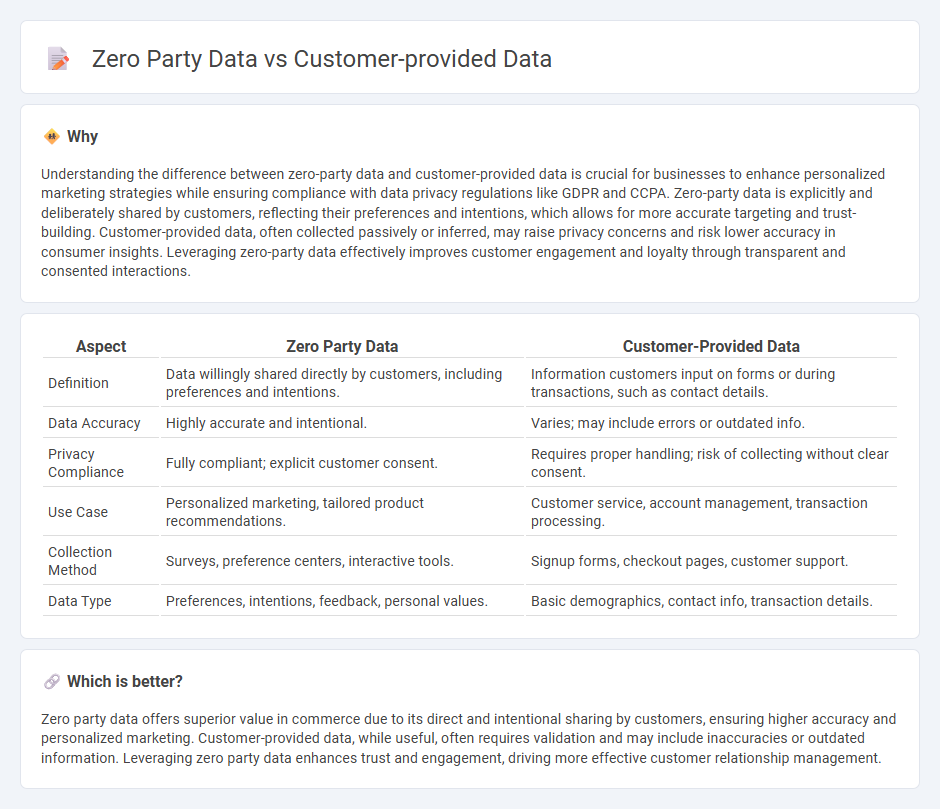
Zero party data is information that customers intentionally and proactively share with a brand, reflecting their preferences, interests, and intentions. Customer-provided data, on the other hand, includes all information supplied by users, whether actively given or passively collected through interactions and transactions. Discover how leveraging zero party data can enhance personalized commerce strategies and improve customer engagement.
Why it is important
Understanding the difference between zero-party data and customer-provided data is crucial for businesses to enhance personalized marketing strategies while ensuring compliance with data privacy regulations like GDPR and CCPA. Zero-party data is explicitly and deliberately shared by customers, reflecting their preferences and intentions, which allows for more accurate targeting and trust-building. Customer-provided data, often collected passively or inferred, may raise privacy concerns and risk lower accuracy in consumer insights. Leveraging zero-party data effectively improves customer engagement and loyalty through transparent and consented interactions.
Comparison Table
| Aspect | Zero Party Data | Customer-Provided Data |
|---|---|---|
| Definition | Data willingly shared directly by customers, including preferences and intentions. | Information customers input on forms or during transactions, such as contact details. |
| Data Accuracy | Highly accurate and intentional. | Varies; may include errors or outdated info. |
| Privacy Compliance | Fully compliant; explicit customer consent. | Requires proper handling; risk of collecting without clear consent. |
| Use Case | Personalized marketing, tailored product recommendations. | Customer service, account management, transaction processing. |
| Collection Method | Surveys, preference centers, interactive tools. | Signup forms, checkout pages, customer support. |
| Data Type | Preferences, intentions, feedback, personal values. | Basic demographics, contact info, transaction details. |
Which is better?
Zero party data offers superior value in commerce due to its direct and intentional sharing by customers, ensuring higher accuracy and personalized marketing. Customer-provided data, while useful, often requires validation and may include inaccuracies or outdated information. Leveraging zero party data enhances trust and engagement, driving more effective customer relationship management.
Connection
Zero party data and customer-provided data are intrinsically connected as both involve information willingly shared by consumers directly with businesses. Zero party data specifically refers to the insights customers intentionally and proactively provide, such as preferences and feedback, enabling personalized commerce strategies. Leveraging this data enhances customer experience and drives targeted marketing efforts without relying on third-party data sources.
Key Terms
Consent
Customer-provided data includes information actively given by users, often requiring explicit consent under data protection regulations like GDPR and CCPA. Zero-party data refers to proactive, intentional disclosures by customers, such as preferences and intentions, offering higher transparency and trust through direct consent mechanisms. Explore how leveraging zero-party data can enhance personalized marketing strategies while maintaining stringent consent compliance.
Personalization
Customer-provided data involves information actively shared by users, such as preferences and purchase history, enabling personalized marketing strategies. Zero-party data, a subset of customer-provided data, is explicitly and intentionally shared by consumers with brands, offering deeper insights into preferences and motivations for enhanced personalization. Explore how leveraging zero-party data can revolutionize your personalization efforts and build stronger customer relationships.
Transparency
Customer-provided data encompasses information that consumers willingly share during interactions, such as purchase history and preferences, enabling personalized marketing strategies. Zero-party data, explicitly and proactively shared by customers, offers greater transparency and trust because it reflects intentional disclosure rather than inferred behavior. Explore how leveraging zero-party data can enhance transparency and deepen customer relationships.
Source and External Links
Customer Data: Definition, Examples, and Applications | LaunchNotes - Customer-provided data includes identity data (basic info like name and contact), descriptive data (interests and preferences), and behavioral data (usage patterns and purchase history), all used to personalize experiences and inform product management.
4 Customer Data Types (With Tips for Collecting Data) | Indeed.com - Customer-provided data covers basic demographic and financial info, along with interaction data such as website visits and engagement with marketing campaigns, collected through various customer relationship programs and platforms.
Customer Data Types and Collection Methods Explained - Qualtrics - Customer-provided data is classified as behavioral data involving customer actions and interactions, operational data involving metrics and demographics, and experience data reflecting customer sentiments and feedback.
 dowidth.com
dowidth.com